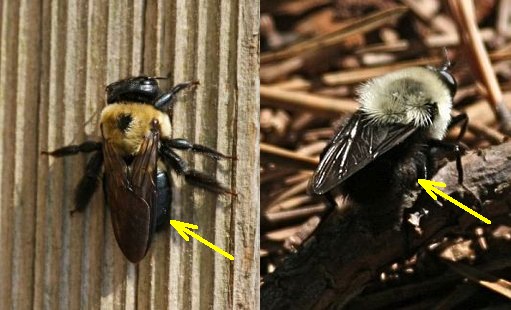
Have you seen bumblebees hovering and dancing near a wooden structure lately? They look like bumblebees but they’re not. They’re carpenter bees.
Carpenter bees are easy to identify once you know this trait: They have shiny black abdomens, noticeable in flight.

Here’s a side-by-side comparison (not to scale) — carpenter bee on the left, bumblebee on the right. Notice the shiny abdomen on the carpenter bee and hairy abdomen on the bumblebee.

Bumblebees build their nests in the ground. Carpenter bees, as their name implies, build their nests in wood. In April you’ll see them face wooden structures, hovering and zooming.
If you see carpenter bees near your house should you worry? I don’t.
Carpenter bees don’t eat the wood and they are barely social. A few females may nest together but that’s the extent of it. Their nests are not large colonies and they don’t have a queen. The entire older generation dies off just before the new young fly so there’s little overlap.
A few carpenter bees have nested somewhere at the front of my 110-year-old house every April for at least a decade. They never become an “infestation.”
Carpenter bees have a long foraging season and are good pollinators. All flying insects are suffering declines, especially honeybees and bumblebees, so we need every pollinator we can get.
I leave the carpenter bees unharmed and watch with wonder.
(photos of stationary bees by Chuck Tague. photo of flying carpenter bee from Wikimedia Commons; click on the image to see the original)
I provide nesting blocks for them to divert them away from one of my out buildings. After they destroyed the eaves on one side. There are so many in the area.
Grant, it’s very cool that you can “train” them to go elsewhere.
DO THEY STING? We have a wisteria in our wooden deck & for many years are fascinated by the carpenter bees as they zoom around when wisteria is in bloom (now). We didn’t realize they have been living in the deck – just figured they come to feast. There are so many feasting that they bump into each other like bumper cars.
Jacqui, see Carolyn’s comment below.
Thanks for posting this Kate, these bees deserve better treatment from us humans.
Many people are startled by the defensive displays the male of this species makes in early spring – they guard potential nest sites by hovering and lots of zig-sagging flight maneuvers, confronting any moving thing in their path! But, they are NOT capable of stinging!
While their boldness can be a little intimadating until you get to know them, they can’t hurt you, so let them be.
I have some that like to sleep on my hydrangea bush until the morning sun dries them. I’ve taken some great photos of them!
I have had these little ones visiting for years. I have an open carport/patio with a roof attached to the house, and the ceiling is wood panels. Every year a few come around and I wind up with some failed attempts (little starter holes) and a few successful holes that they nest in, and I find little piles of sawdust on the ground beneath. I like them and think it’s kind of interesting to watch and I can’t bring myself to care about how the ceiling has come to look a bit polka-dotted over the years. I learned a long time ago that they aren’t aggressive, so I don’t mind sharing space with them.
There is a great little book on Eastern Bumblebees in pdf form (USDA)
Just google identifying Eastern Bumblebees
Also, one available for Western Bumblebees, too
thanks for this kate! i took a closer look today and i have both around my patio! i would have never know the difference if I had not read this! LOL the one does divebomb us whenever we come out the patio door but we let him be.
Interesting information. Carolyn’s post above caught my eye because every Spring, I guess it is male carpenter bees I notice hovering around wooden telephone poles. I have been “confronted” by them, but did not know they do not sting, so I would walk across the street to avoid them. This year, I forgot that I was near one and while it confronted me, I decided to keep walking and I passed by peacefully. The behavior is exactly as Carolyn described though, they hover about the pole and then start flying in a zigzag pattern. I figured it was something territorial when I first saw it, and now I know.
I have actually ‘played’ with them. when confronted, i.e. they fly about 1 foot in front of you, I slowly back up and they keep” chasing” you, thinking they are running you off. With a little work you can move them right and left.
Wow i hate bees ! But i reading all this info about em wondering why their near my windown n its interesting but oh ur bold i COULD NEVER IM TERRIFIED OF EM N HATE THE WAY THEY SOUND ?
You are wrong!!!!! Carpenter Bees are very destructive. I live in a log home and they chewed through the logs and make tunnels just like melted butter!
Kathy, oh my! I’ve never had that problem. Thanks for the info